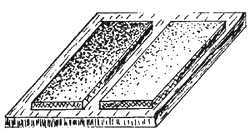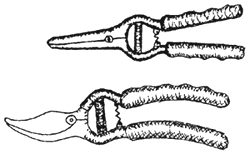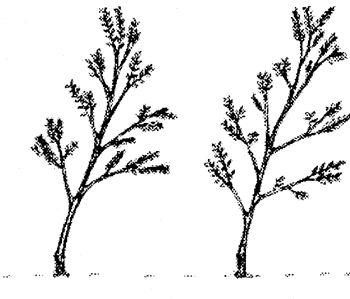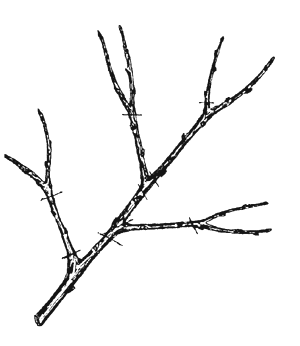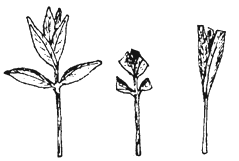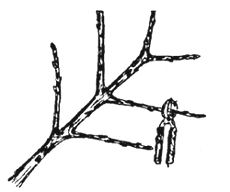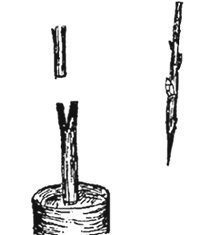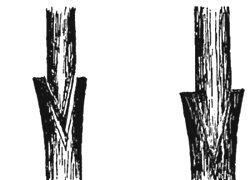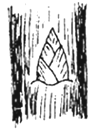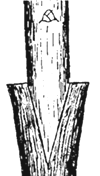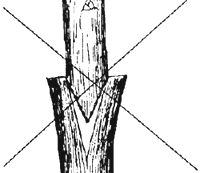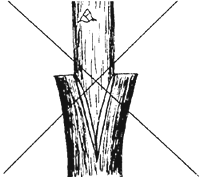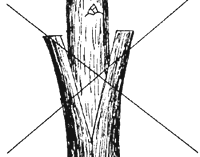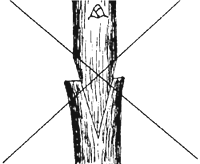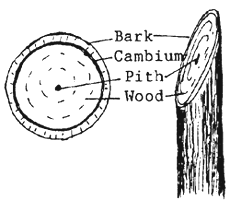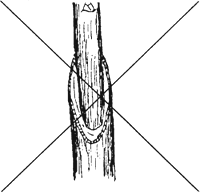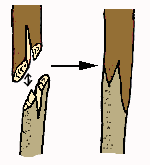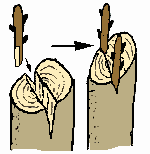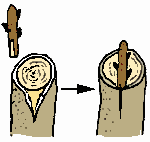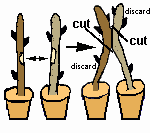Grafting Techniques Types of Grafts Approach Graft Bark or Rind Graft Bridge Graft Budding Techniques Cleft Graft Four Flap Grafting Inarch Graft The Inverted Root Graft: Applications for the Home Garden in Florida, Fairchild Tropical Botanic Garden pdf Root Graft Side Veneer Graft Saddle Graft Splice Graft Texas Inlay Bark Graft Tip Graft Top-Work Grafting of Pecan Trees, Missisipi State University pdf Wedge Graft Whip Graft Grafting In grafting, a scion from the genotype is united with a stock (root stock) from another plant. The stock is usually a seedling, rarely a rooted cutting or a planted air-layered branch. For a good result of grafting the root stock as well as the scion has to be in good conditions, and the two parts should be compatible. The best time of grafting is 1–2 months before leaf flushing when the scions have dormant vegetative buds, i.e. the dry season just before the onset of the wet season; or in cool climates the cool season just before the onset of the warm season (spring). At that time the buds are just about to sprout and the level of the plant hormone auxin is high. Grafting can be done in the nursery in which case the stock is growing in a container. For some species grafting can take place under field conditions, provided the graft union is well protected after the grafting. 1 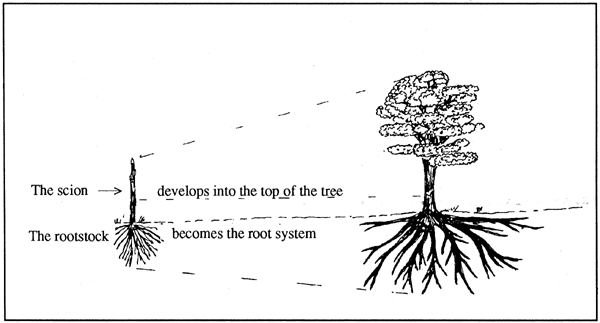 Fig. 1 NOTE: In grafting, as well as budding, the vascular cambium of the scion or bud must be aligned with the vascular cambium of rootstock. In woody plants the cambium is a very thin ribbon of actively dividing cells located just below the bark. The cambium produces conductive tissue for the actively growing plant . This vascular cambium initiates callus tissue at the graft and bud unions in addition to stimulating tissue growth on the basal ends of many vegetative cuttings before they have rooted. 2 Accessories used in Grafting Propagation Most tools and other accessories used in vegetative propagation can be purchased at garden/horticultural dealers. 1
Grafting wax: Various types are commercially available. Some are hot types, which are melted before use and which harden when cooled down. The waxes are applied with a small paint brush. Vaseline can be used as an alternative. 1 How to sharpen a knife To sharpen the grafting knife, the initial grinding may be done with a medium grit stone, but a hard, fine-grit stone should be used for the final sharpening. The stone should be wet with water or oil during sharpening. Do not use a carborundum stone, because it is too abrasive and will grind off too much metal. Most grafters prefer to use knives beveled only on one side, the back side being flat, whereas others prefer a knife beveled on both sides. In sharpening the knife, hold it so that only the edge of the blade touches the stone in order that a stiff edge for cutting can be obtained. Use the whole width of the stone so that its surface will remain flat. A correctly sharpened knife of high-quality steel should retain a good edge for several days' work, with only occasional stropping on a piece of leather. 1
From Hartman and Kester 1983 Handling of Vegetative Propagation Material Vegetative propagation material is in general much more sensitive to desiccation and other damages than seeds. Special care must be taken during handling. The physiological characteristics of the propagation material should be taken into account. Following measures should be taken: Material should be kept out of direct sunlight. Material should be taken as close in time and space to the operation as possible. Long storage should be avoided. If storage is necessary, it should be in a cool and moist place. Prevention measures against desiccation should be taken during all transport and storage. The material should be handled carefully so that buds will not be damaged. All flowers and flower buds should be removed from the material. Vegetative material possesses polarity, i.e. physiological difference between distal and proximal end. In vegetative propagules where it is difficult to distinguish the two ends, one end should be marked. 1 Effect of the Origin of the Vegetative Propagation Material Although genetically identical, the propagation material may be effected from the position on the mother tree from where it was collected, and permanently or temporarily continue to show signs of this origin. For example, it may continue to grow like a branch when it is used as scion, cutting or air-layered material. The phenomenon is called topophysis or plagiotropic growth. Periphysis is another phenomenon where plant material shows characteristics according to the place of the tree from where it was collected, e.g. sun branches or shade branches. Scions for grafting and material for air-layering should usually be taken from new shoots of mature trees. For cuttings, hedged plants are usually the best source of juvenile material. 1
Grafted plants: The trees on the left show a normal upright growth form (orthotropic growth while those on the right tend to grow like branches (plagiothropic growth). Cuttings Cuttings are parts of plants that are cut and separated from the mother tree and brought to form roots and/or shoots and eventually develop into entire plants. Cuttings can be formed from roots, leaves or stems. Propagation from stem cuttings is the most important method in forestry. The age of the tree and branch from where cuttings are collected has a very strong effect on rooting. Cuttings taken from young trees usually have a much better rooting than cuttings from older material. 1 Time of Collection Most species have distinctive periods during the year when rooting is best. The period varies with species and area. In general, it appears that anytime shoot elongation is not taking place, is suitable for rooting. The best time appears to be about a month before leaf flushing. Dormancy is usually restricted to the cool (temperate) or the dry (subtropical or tropical) season. 1 Types of Stem Cuttings There are two main types of stem cuttings: Softwood cuttings (leafed cuttings) are young soft succulent cuttings with leaves (sometimes pruned). Hardwood cuttings are made of matured, dormant hardwood after the leaves have been shed. Tip cuttings possess terminal buds; basal cuttings are without terminal buds. Some general characteristics of the two types are mentioned below:
The cuttings can sometimes be reduced to consist of only a small piece of stem with a single leaf and an axillary bud attached, i.e. a single node. Such cuttings are called nodal cuttings. They are especially useful when the cutting material is scarce. 1 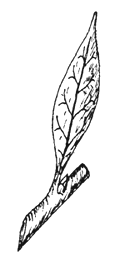 Fig. 6
Note: There is a strong polarity in cuttings. When rooting hardwood cuttings, care should be taken not to plant the cuttings upside down. When it is difficult to distinguish between the top (distal end) and the base (proximal end), it is advisable to make one of the cuts a slant. 1 Stages in Grafting
The Root Stock Rootstocks are usually grown from seeds. Good material should be used for root stock, i.e. plants with a well developed root system and resistance to soil-borne diseases. The seedlings are kept in the nursery longer and are grown to a bigger than normal planting size, since they have to fit with the scions. For most species the plants will be about 50–70 cm high when grafting takes place. Therefore seedlings should be grown in relatively big pots, i.e. at least 10–15 cm diameter, depending on species. The root stock is fit for grafting when the stem is about 0.6–1.2 cm diameter at the upper third. 1 The root stock should be tendered carefully before and after the grafting. 1 The Scion Conditions vary according to species. Following characteristics are guidelines: Scions should be taken from the upper part of the tree. Scions should be taken from vigorously growing branches. Scion length should be about 15–25 cm. Scion diameter should be according to the size of the stock, i.e. 6–12 mm in diameter. Scions should be without flower buds. Scions should have well developed vegetative buds in a dormant stage. The scions should be kept moist and cool until the grafting takes place. Grafting should be done as soon as possible after collection. 1 Bud development:
The Cut and Joint A proper cut requires a very sharp knife with a straight edge. The cut should be clean and smooth with no fibres on either side. The cut should be done in one movement. Except from top cleft grafting, the technique implies fit cuts of stock and scion respectively. A cutting angle of ≈ 20° for splice, whip or wedge graft is suitable. It is important that the cut angle is the same in stock and scion since a different angle of two cuts will result in a bend junction. 1 The size of the scion and the root stock is compared in order to find fit pairs. The place of cutting at the root stock can also be adjusted to fit the size of the scion. 1 When putting the two parts together they should fit so that there is as little gaps and exposed wood and cambium on either side as possible. Some examples of cuts and joints in top cleft grafting are shown below. 1
The two joined parts should have maximum cambial contact. If the root stock has a bigger diameter than the scion, the joint should fit in one side only. 1 A scion should never have larger diameter than the root stock. An example of a joint in splice grafting where the scion is considerably smaller than the stock is shown below. 1
When the two parts are brought together, grafting tape or string is wrapped around the joint. The wrapping should be tight and completely cover the joint. It serves 3 purposes: 1) It keeps the two parts together in a fixed position until they have grown together. 2) It restricts evaporation from the cut. 3) It excludes water and air, and entry of fungi at the joint. 1 What Type of Graft to Use Types Used to Repair Damage
Types Used When Scion and Stock are Approximately Equal in Size
Types Used When Scion is Smaller than Stock
What Can Go Wrong? The two parts may not unite and the plant will die due to: Incompatibility of the root stock and scion/bud. Lack of sufficient cambial contact due to in-proper cuts or/and unfit joint. Desiccation of the graft union. Water or infection is entering the joint. The plants dry out due to lack of watering or too dry atmosphere. Bad timing of the grafting, i.e. in-proper stage of development of the scion/bud. The scion/bud has dried out before grafting. The root stock is in a bad condition. The plant tissue was damaged by too hot grafting wax. Damage or loss of the bud(s). 1 Care of Grafted Plants Grafted plants are susceptible to evaporation from the cut until callus have been formed to close the wound. Therefore it should be kept in a humid atmosphere until the two parts have grown together. In the nursery they can be kept in a humid atmosphere in a mist house. In the field, the grafted plant can be covered by a plastic bag. After the parts have united, the wrapping material should be removed and the plants still be kept in the nursery for some time to harden. Normal nursery practices of watering, root-pruning etc. should be carried out until the plants are planted out. Shoots and branches that grow out from the root stock, i.e. below the grafting point should be removed. In order to help in identifying the graft union for a long time, the place of union may be painted. If flowers occur in the first year or before the vegetative parts have been sufficiently developed, they should be removed. 1 Grafting Waxes Sometimes grafting wax or vaseline is used together with the wrapping material in order to help sealing the union. The wax can be a cold type or a hot type. The hot type solidifies upon cooling and must be reheated just before use. It is important that the hot type wax be at the right temperature when it is used. If the wax is boiling, it will injure the plant tissue; if the wax is too cool, it will not flow easily into all the crevices in the bark, thus leaving openings for the entrance of air, water and fungi spores. 1 The important characters of a hot type grafting wax are the following: Melting point: The melting point should be so low that the melted wax will not damage the plant tissue but so high that it will not melt when exposed to extreme field themperatures. 1 Viscosity: The wax should have a consistence so that it will be thin flowing and applicable in a wide temperature range, e.g. 50–70°C. 1 There are several techniques on grafting. The various methods are used in different plant material and for different purposes. However, often the use is according to personal preference of individual nurserymen, some preferring one type, others another. 1 Grafting waxes serve two purposes: (1) to seal over the graft union and prevent loss of moisture, and (2) to prevent entrance of disease and decay-causing organisms. Good grafting waxes have these qualities: 1) Adhere to plant surfaces and are not washed off by rain. 2) Do not get brittle and crack. 3) Do not melt in hot weather. 4) Remain pliable to allow for swelling of the scion and enlargement of the stock. 2 There are three general types of waxes-hot, hard and cold. Hot or cold waxes are the most satisfactory for commercial operations. A hot wax may be made by heating 4 pounds resin, 1 pound of beeswax, 1 pint of raw linseed oil and 1 ounce of lampblack. Hard wax may be made by heating together 4 parts of resin, 2 parts of beeswax and 1 part of tallow. Cold waxes should be purchased commercially. 2 NOTE: The temperature of grafting wax is critical. It must be hot enough to flow but not so hot as to kill plant tissue. Recently, paint-like sealants have replaced wax in many areas because they are easier to use and require no heating. 2 Definitions and Terminology 1 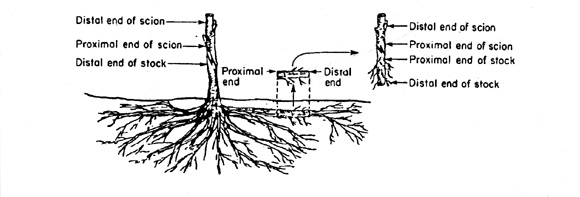 Fig. 15 Callus:
The mass of parenchyma cells that develops from and around wounded
plant tissues in order to diminish evaporation from the wound and
initiate healing. In grafting it occurs at the junction of a graft
union, arriving from living cells of both scion and stock. The
production and interlocking of these parenchyma (or callus) cells
constitute one of the important steps in the healing process of a
successful graft.
Cambium: A thin tissue of the plant located between the bark and the wood. Its cells are meristematic, i.e. they are capable of dividing and forming new cells. For a successful graft union, it is essential that the cambium of the scion be placed in close contact with the cambium of the stock. Clone: A population of genetically identical cells or individuals. Such a population is obtained by mitotic division or by asexual reproduction. Distal: The distal end of either the root or the shoot is that furthest from the stem-root junction of the plant and nearest to the tip of the shoot or root. Alt. proximal. See polarity. Dormant/dormancy (buds): A bud which have stopped its development for a period due to unfavourable environmental conditiones (e.g. a dry or cold season). A dormant bud will sprout as a response to improved growth conditions or a “biological clock” e.g. longer days. Grafting: The connection of two pieces of living plant tissue in such a manner that they will unite and subsequently grow and develop as one plant. Grafting wax: Substance applied on the graft union in order to minimise desiccation and exclude water access. Graft union: The site of the grafted plant where the scion and the root stock are united. Hedging: Trimming trees and keeping them low in order to overcome or bypass the poor rooting and often poor form of cuttings from old trees. Cuttings from hedged plants tend to maintain their young physiological age. Hormone: A substance that has a marked effect on a specific plant part and produces this effect when present in very low concentrations, e.g. promotion of root, shoot or flower development. Hormones are produced within the plant but artificial synthesized plant hormones applied to the plant part have the same effect. Incompatibility (graft incompatibility): Inability of the stock and the scion to form or maintain a union that will result in the desired plant growth. Node: A point of the stem from which one or more leaves arise. In the mature stem the nodes are usually well separated by internodes which elongate during growth. Ortet: The original plant from which a clone has been derived. Orthotropic growth: The situation where the vegetative propagule assumes an upright or normal tree form. Ant. plagiotropic growth. Periphysis: Variation of growth habit of vegetative propagules due to their origin from different environments, such as shade and sun leaves on an individual tree. Plagiotropic growth: The situation where the vegetative propagule does not assume a normal tree form but continues to grow like a branch. Ant. orthotropic growth. Propagule: A plant part such as a bud, tuber, root or shoot, used to propagate an individual vegetatively. Polarity: The condition that plant parts maintain their spatial orientation when separated from the mother plant. The phenomenon is important in cuttings and grafting. See proximal and distal. Proximal: The end of either the root or the shoot that is nearest the stem-root junction of the plant. See polarity Ramet: An individual member of a clone. Scion: An aerial plant part, often a branchlet, that is grafted onto the root bearing part (stock/root-stock) of another plant. Stock/root stock: The lower portion of the graft, which develops into the root system of the grafted plant. It may be a seedling, a rooted cutting or a layered plant. “Take”: The “slang” term for the phenomenon of the successful union of stock and scion and growth of the grafted plant. Topophysis: The phenomenon that occurs when scions, buddings and rooted cuttings maintain for some time the branchlike growth habit (plagiotropic growth) they had as shoots on the ortet. Further Reading Collecting and Storing Graft Wood, Aggie Horticulture®, Texas A&M AgriLife Extension Plant Propagation Methodologies, University of Florida pdf Top Working Lychee Trees, Archives of the Rare Fruit Council of Australia Top Working and Bridge Grafting Fruit Trees, Cornell University, Cooperative Extension pdf Plant Propagation by Grafting and Budding, Pacific Northwest Extension publication pdf Back to Propagation Page |
|||||||||||||||||||||||||||||||||||||||||||||||||||||||||||||||||||||||||||||||||||||||||||
| Bibliography 1 Schmidt, Lars. "Guidelines on Grafting, Air-Layering and Cuttings." Vegetative Propagation, Food and Agriculture Organization of the United Nations, May 1993, www.fao.org/docrep/006/ad224e/AD224E15.htm. Accessed 7 Mar. 2018. 2 Bilderback, Ted, et al. "Grafting and Budding Nursery Crop Plants." North Carolina State University Cooperative Extension, June 30, 2014, content.ces.ncsu.edu/grafting-and-budding-nursery-crop-plants. Accessed 16 May 2018. Video v "How to Graft White Sapote Fruit Trees - Grafting for Beginners!" Sulcata Grove, 11 Nov. 2017, www.youtube.com/watch?v=LDuKNNu5b-s. Accessed 16 June 2021. Photographs Fig. 1 "Grafting." Guidelines on Grafting, Air-Layering and Cuttings, Vegetative Propagation, May 1993, www.fao.org/docrep/006/ad224e/AD224E14.htm. Accessed 9 May 2018. Fig. 2,3 "Grafting." Guidelines on Grafting, Air-Layering and Cuttings, Vegetative Propagation, May 1993, www.fao.org/docrep/006/ad224e/AD224E15.htm. Accessed 9 May 2018. Fig. 4 "Grafting." Guidelines on Grafting, Air-Layering and Cuttings, Vegetative Propagation, May 1993, www.fao.org/docrep/006/ad224e/AD224E16.htm. Accessed 9 May 2018. Fig. 5,6,7 "Grafting." Guidelines on Grafting, Air-Layering and Cuttings, Vegetative Propagation, May 1993, www.fao.org/docrep/006/ad224e/AD224E07.htm. Accessed 9 May 2018. Fig. 8 "Grafting." Guidelines on Grafting, Air-Layering and Cuttings, Vegetative Propagation, May 1993, www.fao.org/docrep/006/ad224e/AD224E18.htm. Accessed 9 May 2018. Fig. 9 "Grafting." Guidelines on Grafting, Air-Layering and Cuttings, Vegetative Propagation, May 1993, www.fao.org/docrep/006/ad224e/AD224E16.htm. Accessed 9 May 2018. Fig. 10,11 "Grafting." Guidelines on Grafting, Air-Layering and Cuttings, Vegetative Propagation, May 1993, www.fao.org/docrep/006/ad224e/AD224E19.htm. Accessed 9 May 2018. Fig. 12,13,14 Reed, D. W. "Budding Techniques." agrilifeextension.tamu.edu. Accessed 17 May 2014. Published 12 Apr. 2014 LR. Last update 18 June 2021 LR |
|||||||||||||||||||||||||||||||||||||||||||||||||||||||||||||||||||||||||||||||||||||||||||



